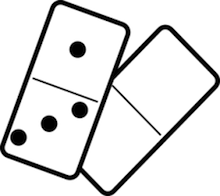Playing games with the grandkids is always fun, but a lot of games they’re familiar with, I’ve never heard of — but they’re still fun and maybe more fun as I listen to the grandkid’s explanation of how they’re played.
It’s also fun to teach them about the “old” classic games, like checkers and dominoes. I particularly like dominoes because besides being fun, there’s counting involved.
The game can be spelled two different ways — dominoes or dominos. In terms of grammar, it is considered correct with or without the ‘e.’ (The plural form of words ending in ‘o’ can be spelled either way, depending on the word. For example, the plural of piano just adds an ’s,’ while the plural of potato adds ‘es.’ The more common plural spelling of domino is dominoes.

To this day, no one really knows how or why the game is called dominoes. Some historians believe it was named after the black hooded accessory worn by priests many years ago. The best story I’ve heard about the name is that dominoes were developed as a game by French monks and named after the first lines of Psalm 110, which in Latin reads Disit Dominos mea (“said my Lord.”)
The oldest known writings regarding the game dates back to the 12th century — Chinese writers of the Yuan Dynasty described it as a gambling game sold by peddlers. They referred to the game as “pupai.”
The modern version of dominoes comes from Europe. It first appeared there in the early 18th century, The modern European domino sets differ from the Chines sets —the European versions have 28 tiles, whereas the Chinese ones use 32 tiles. Chinese sets were initially designed to represent all the possible “faces” or throws of two 6-sided dice.
The Netherlands has held an annual event since 1986 called Domino Day. It has set records including the longest domino spiral, the highest domino climb, and the largest domino structure.
The game inspired the phrase “domino effect,” in reference to small events compounding to create a catastrophe. Standing the times closely together or their sides and then tapping the first one to cause the second and then the third and eventually all of the times in the line to topple is what is known as “the domino effect.”
The game of dominoes has inspired a popular pizza restaurant to use a domino tile as it logo. Domino’s Pizza was established on December 9, 1960, in Michigan.
The spots on dominoes are known as “pips,” and the game pieces are called “tiles” — but my grandad always called them “bones.”
The game involves matching the game pieces (tiles or “bones”) —each domino has a number of spots, or none at all, at each end of the tile that must be matched with another of the same number of spots. Playing dominoes with our grandkids is a good way to teach and reinforce basic math skills like counting, addition and multiplication. It also helps develop critical thinking, strategic planning and pattern recognition. I’m not sure how much of that me or the grandkids really learn, but we do have fun — and — it is educational. Actually, it’s a lot like life — you gotta play the “bones” you’ve drawn. It doesn’t matter if you’ve got seven doubles in your hand….
— 30 —
